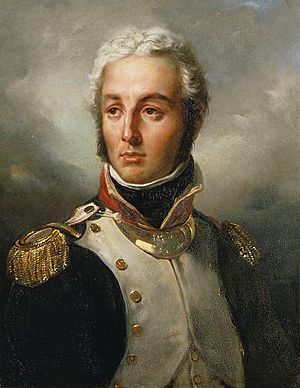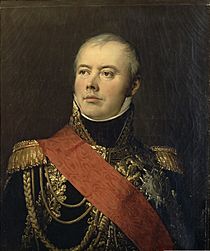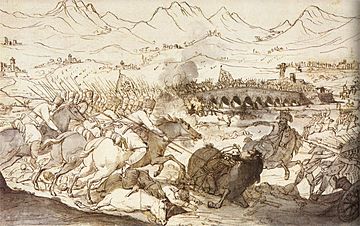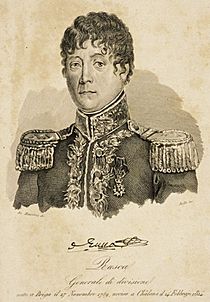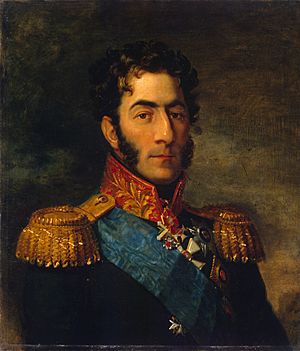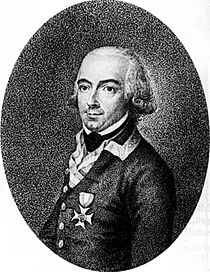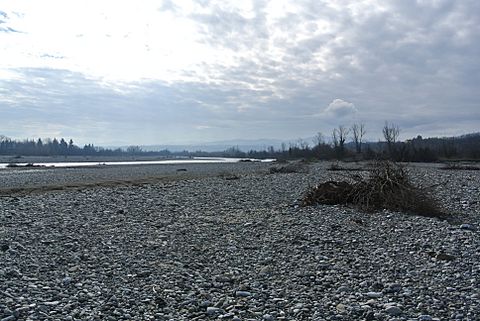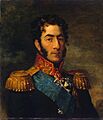Battle of Trebbia (1799) facts for kids
Quick facts for kids Battle of the Trebbia (1799) |
|||||||
|---|---|---|---|---|---|---|---|
| Part of the Italian campaigns in the War of the Second Coalition | |||||||
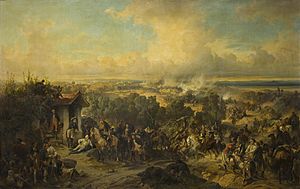 Suvorov's battle at Trebbia by Alexander Y. Kotzebue |
|||||||
|
|||||||
| Belligerents | |||||||
|
|||||||
| Commanders and leaders | |||||||
| Strength | |||||||
| c. 33,000 | |||||||
| Casualties and losses | |||||||
| 16,000–18,000 killed, wounded, captured, & missing (incl. 8 generals and 502 officers) ...more calculations 7 guns, 8 standards |
5,500–6,000 killed, wounded, captured, & missing (incl. 3 generals and 149 officers) ...more calculations |
||||||
The Battle of Trebbia (June 17–20, 1799) was a big fight near the Tidone, Trebbia, and Nure rivers in Northern Italy. It was part of the War of the Second Coalition. The battle was between the combined armies of Russia and Austria, led by Alexander Suvorov, and the French army, led by Étienne Macdonald.
Even though the armies were about the same size, the Russian and Austrian forces won a huge victory. They lost about 5,500 soldiers, while the French lost around 16,500. This important battle took place west of Piacenza, a city about 70 kilometers (43 miles) southeast of Milan.
In the spring of 1799, Austrian and Russian armies pushed the French out of much of northern Italy. They had won battles at Magnano and Cassano. They also started to surround the important fortress of Mantua.
Macdonald gathered the French troops from southern and central Italy to form a new army. He decided to move north to challenge the enemy. Instead of taking the safer route along the west coast, Macdonald bravely chose to move east of the Apennine Mountains. He hoped that Jean Victor Marie Moreau's French army would join him there.
After defeating a smaller Austrian force at Modena, Macdonald's army moved west along the south side of the Po River. Suvorov quickly brought his Russian and Austrian allies, led by Michael von Melas, together to stop the French. The battle lasted four days in very hot weather. Even though the Allied troops were tired from marching, they immediately joined the fight.
On June 17, the first French troops met a small Austrian force led by Peter Karl Ott von Bátorkéz along the Tidone River. Ott's troops quickly received help from the main Austro-Russian army. The French then had to fall back to the Trebbia River. Suvorov attacked on June 18. The French managed to hold off the Allied attack but had to leave their positions on the west bank of the Trebbia.
By June 19, almost all of Macdonald's army was together. He ordered an attack, but it was not well-planned and failed everywhere. Macdonald realized that Moreau's help was not coming. That night, he ordered his defeated French army to sneak away to the south and west.
On June 20, along the Nure River, the Allies caught a French rearguard (a small group protecting the main army's retreat). Instead of strong help arriving for the French in northwest Italy, only the weak remains of Macdonald's army showed up.
The Battle of Trebbia is considered one of the greatest victories in Alexander Suvorov's military career. It is remembered alongside his famous storming of Izmail.
About 3,000 soldiers from the Polish Legions fought in this battle. They were serving the Cisalpine Republic (a French-controlled state in Italy). Because of their bravery, the Battle of Trebbia is honored on the Tomb of the Unknown Soldier, Warsaw, with the words "TREBBIA 17 - 19 VI 1799". Macdonald's army also included soldiers from the Lombard Legion.
Contents
Why Did This Battle Happen?
Early Coalition Victories
The War of the Second Coalition in northern Italy started with the Battle of Verona on March 26, 1799. This battle between the Austrian army and the French Army of Italy ended without a clear winner.
However, the next battle, Battle of Magnano on April 5, was a big win for the Austrians. They lost 6,000 soldiers, but the French lost 8,000 men and 18 cannons. This defeat badly hurt French morale. Their commander, Schérer, asked to be removed from his post.
Schérer's strong position behind the Mincio River was outflanked (attacked from the side) by 12,000 Austrians. So, he left 12,000 troops to defend the important fortress of Mantua. He also sent 1,600 more to protect Peschiera del Garda and retreated west on April 12. Two days later, Alexander Suvorov arrived with a Russian army and took command of both the Austrian and Russian forces.
On April 27, the combined Allied forces, led by Suvorov, defeated Jean Victor Marie Moreau's French army at the Battle of Cassano along the Adda River. The next day, at Verderio, a French division was surrounded. After fighting, 2,700 French soldiers surrendered. These defeats forced Moreau to retreat. He left 2,400 men to defend the Milan citadel.
On May 6, the Peschiera fortress surrendered to the Austrians. On May 11, Pizzighettone and 1,500 French soldiers also gave up. On May 12, Suvorov's officer, Andrei Grigorevich Rosenberg, had a small setback at the Battle of Bassignana. But then Suvorov's troops won the First Battle of Marengo on May 16. Ferrara, Ravenna, and Milan all surrendered to the Austrians by May 24.
Meanwhile, 30,000 Allied soldiers under Suvorov moved along the north bank of the Po River towards Turin. On May 26, their advance group captured Turin. They seized its weapons factory and over 300 cannons. The French soldiers there retreated to the citadel, where they were surrounded.
By early June, the main Allied army of about 47,000 troops was camped near Turin. They were led by Suvorov, Rosenberg, and Michael von Melas. Other Austrian forces were watching mountain passes and besieging Mantua. Suvorov also called for more troops to join him in Milan. To face this large force, Moreau had about 25,000 soldiers spread out in different divisions. But the Allies knew that Jacques MacDonald had a strong French army in southern and central Italy.
Macdonald's Bold Plan
On April 14, 1799, the French government ordered Macdonald to help the French forces in northern Italy. So, he gathered his Army of Naples and moved north. He left local forces to control southern Italy. Macdonald reached Rome on May 16 and Florence ten days later.
From Florence, the safest way to reach Genoa would have been along the west coast road. This would keep the Apennine Mountains between his army and the Allies. However, Macdonald believed the coast road was too difficult for his cannons. He also worried that Austrian troops might block his way. But perhaps the real reason was that Macdonald wanted to make a big entrance by fighting his way through the Allied forces.
To do this, he asked Moreau to march north and east to meet him near Piacenza. This was a risky plan that would put Moreau's army right in the middle of the enemy. After crossing the Apennines, Macdonald hoped to defeat some of the Austrian forces. As his army moved north, it grew to include about 36,700 soldiers.
On June 9, Suvorov learned that Macdonald's army had grown and that the French had captured Pontremoli. This news came from Peter Karl Ott von Bátorkéz, who commanded 5,000 Austrian soldiers near Parma. Suvorov immediately ordered Ott to slowly retreat to Stradella and hold that position. The Russian commander quickly decided to move east to face Macdonald.
Most of the Austro-Russian army marched to Asti, arriving on June 11. They reached the Bormida River near the French-held fortress of Alessandria on June 13. That day, Suvorov got clear news of Macdonald's attack. Meanwhile, a French fleet arrived in Genoa on June 2 with more French soldiers. Reports suggested that Moreau was about to come down from the mountains. Suvorov ordered some of his troops to stay near Alessandria to watch Moreau. The rest of his army focused on Macdonald.
Macdonald's army crossed the Apennine Mountains in four main groups. The easternmost group moved from Florence to Bologna. The next group moved from Pistoia to Modena, with Macdonald himself. Farther west, another group moved down the Secchia River valley. The westernmost group marched from Borgo Val di Taro down the Taro River towards Parma.
Because Macdonald's attack across the mountains was so unexpected, it surprised the Austrian forces. Macdonald planned to destroy an Austrian division by attacking it directly while other French groups surrounded it. However, Macdonald lost contact with one of his groups. Still, Macdonald attacked the Austrians at Modena with two divisions. On June 12, in the Battle of Modena, the French caused 750 Austrian deaths and injuries. They also captured 1,650 men, eight cannons, and three flags. The French lost 400 killed and wounded, and 200 captured. During the chase, Macdonald was attacked by French Royalist cavalry and was cut on the head and arm before his own soldiers saved him.
The fortress of Alessandria controlled the only crossing of the Bormida River. So, the main Austro-Russian army had to wait for a bridge-building train, which finally arrived on June 15. By 5:00 pm, the bridge was ready. Suvorov's army crossed and marched all night to reach Castelnuovo Scrivia by the morning of June 16. After only three hours of rest, the soldiers continued their fast march to their camp between Casteggio and Casatisma. In 24 hours, the Allied army covered 56 kilometers (35 miles) in the scorching heat. Many soldiers collapsed from exhaustion.
To protect his right side, Suvorov sent a small group of soldiers, including Cossacks and dragoons. He also prepared for a possible defeat by ordering bridges to be built across the Po River. By this time, more Allied troops arrived to help with the siege of Alessandria and to keep Moreau contained. To stop Macdonald from helping the besieged Mantua, the Austrians placed several thousand troops on the north bank of the Po.
On June 16 at 10:00 am, Macdonald's leading troops arrived near Piacenza and began to push against Ott's forces. Suvorov repeated his orders for Ott to fight and retreat to the Stradella pass. By this time, Austrian engineers had made the Piacenza citadel ready for defense. French troops attacked Ott, while other French soldiers tried to go around the Austrians from the south. That night, Suvorov's chief of staff, Johann Gabriel Chasteler de Courcelles, rushed to Ott's position with dragoons and artillery. More troops followed. If Ott could hold his position along the Tidone River, it would give the Austro-Russian army enough space to set up their battle lines. If Ott was forced back into the narrow Stradella position, it would be very hard for the Allies to form up, and it might even lead to a chaotic retreat.
The Battle Begins
Tidone River - June 17
The Tidone River flows north into the Po River, west of Piacenza. It has steep banks and is about 100 meters (109 yards) wide, making it a good defensive spot. Like the Tidone, the Trebbia River's bed is full of white stones.
On June 17, at 8:00 am, the French began their attack against Ott's positions behind the Tidone. They had about 18,700 soldiers. The French divisions were arranged with Victor on the right, Rusca in the center, and Dombrowski on the left. Macdonald was sick in bed in a nearby village because of his wounds from Modena. Victor, as the senior officer, should have taken charge, but he stayed in Piacenza. This led to poor coordination among the French.
Despite this, the French attacked fiercely. They pushed the Austrian Jägers out of their positions on the west bank. As Dombrowski's troops attacked from the south, Victor's soldiers fought their way to the village of Sarmato. There, they were stopped by an Austrian artillery battery and two battalions. Chasteler, who was with Ott, urged him to hold on and went back to hurry his own troops forward. At 1:00 pm, Chasteler's men arrived and joined the fight. Still, at 3:00 pm, the French captured Sarmato and its cannons. This forced Ott's troops back to a position in front of Castel San Giovanni.
Soon after, Melas arrived with more Austrian soldiers and hussars. Suvorov inspired his Russian troops by suddenly appearing at different points along the marching line. If inspiration wasn't enough, Cossacks were used to push stragglers back into line. Chasteler's units rushed south to block a flanking move by Dombrowski's division. Other Russian and Austrian units were sent into battle near Castel San Giovanni.
One Russian general, Bagration, asked Suvorov if they could wait for more tired soldiers to arrive. Suvorov whispered back, "Macdonald doesn't even have 20 men; attack with God!" Despite the odds, the French continued to attack bravely. Slowly, the Allies gathered in two battle lines in front of Castel San Giovanni. Ott had held on with help from Chasteler, and then the quick arrival of Melas, Suvorov, and Bagration gave the Allies a strong advantage with about 30,600 regular troops.
Suvorov wanted to gather as many troops as possible for the attack. Officers were sent back to bring up stragglers. They also expected help from another general, Kray. However, neither Kray nor another general named Chubarov (who arrived later with 1,300 men) arrived that day. The troops were only reinforced by stragglers who joined the fight directly from their march.
Finally, the Allies recaptured Sarmato and the abandoned Austrian cannons, forcing the French to retreat. The French fell back stubbornly, using the terrain to stop Austrian cavalry charges. The fighting ended by 9:00 pm. The French lost about 1,000 killed and wounded, plus 1,200 captured. Allied casualties were not recorded for this day. Based on the day's results, Suvorov, with up to 15,000 men, had decisively pushed back 18,000 French soldiers.
Trebbia River - June 18
Macdonald was surprised to face such a large Austro-Russian army. He felt his 22,000 soldiers were outnumbered and should retreat. But he hoped that Moreau might soon arrive and attack the Allied rear. So, he decided to hold out until his last divisions could join the battle. Macdonald also knew about a force under Jean François Cornu de La Poype that could threaten the Allied southern flank. On the 18th, a detached Allied force surprised La Poype's 1,500 French and 2,000 Genoese troops at Bobbio, sending them fleeing back to Genoa.
On the morning of June 18, the injured Macdonald checked on his army. He found his men ready to fight and the enemy not moving. Meanwhile, Suvorov and Chasteler planned to attack the French with three columns. The main attack would be on the right, aiming to break Macdonald's flank by advancing from the Tidone to the Trebbia and then all the way to the Nure River. With luck, the French would be pushed back against the Po River.
Suvorov wanted to start the attack at 7:00 am, but the Allied soldiers were too tired. So, it was delayed until 11:00 am. Scouts reported that the French were defending behind the Trebbia, with advanced positions in several villages from north to south.
Bagration's advance guard crossed the Tidone and attacked Dombrowski's Polish Legion at 2:00 pm, surprising them. A Polish battalion tried to attack the Russian rear, but it was quickly surrounded by Russian infantry, Austrian dragoons, and Cossacks. 230 men were forced to surrender. A quick-thinking French officer brought more French divisions to the west bank of the Trebbia, where they stopped and pushed back Bagration's troops.
Rosenberg brought his reserve division into the fight, while Suvorov personally rallied the shaken Russian infantry. "Halt!" cried Suvorov, and the retreating troops stopped. A hidden battery fired cannons into the French, who were shocked. "Press on! Stupai, Stupai! With the bayonet! Hurrah!" Suvorov continued to yell. The Russians soon gained the upper hand and forced Rusca to pull back to the east bank of the Trebbia, which his men did in good order.
The fighting in the center began when Allied cavalry clashed with French horsemen and drove them back. Starting at 5:00 pm, Förster slowly pushed back the right side of Victor's division. Finally, the French left Gragnano and fell back across the Trebbia.
Salme's advance guard, positioned north of the highway, was mostly unchallenged that day. Around 2:30 pm, more French divisions crossed the Trebbia to support Salme. Seeing these French reinforcements, Melas decided not to send in his reserve division. Generally, during the two-day battle at the Trebbia, Melas was slow and unsure, sometimes not fully following Suvorov's orders. This put the Allied troops at risk of a French breakthrough.
The Allied commander sent Ott forward at 6:00 pm. The Austrians easily pushed aside Salme's outnumbered unit. Together, Ott and Fröhlich pushed the French back beyond the Trebbia by evening. That night, in a strange move, Rosenberg took two Russian battalions across the Trebbia. They somehow got through the French lines and routed a French group, freeing some prisoners. At 3:00 am, Rosenberg's group returned to the west bank, again without being noticed by French guards. Four squadrons of dragoons tried a similar move but were spotted and driven off.
Both groups missed a pointless battle that happened earlier. Hearing what they thought was Moreau's artillery, three French battalions launched a sudden attack at 9:30 pm, surprising an Austrian battalion. Melas called for reinforcements, and Prince Liechtenstein charged into the fight with his dragoons. Artillery from both sides fired into the chaos, causing many friendly fire casualties. After great effort, the leaders on both sides managed to stop the senseless fighting by 11:00 pm. The total Allied force in the battle on June 18 was around 22,000, which was equal to the French forces.
Trebbia River - June 19
Chasteler sent orders for the Allied army to start their attack at 6:00 am on June 19. However, the plan didn't reach Melas until 11:00 am. In the meantime, Melas noticed strong enemy forces at the north end of the battle line. He sent 12 cannons to the west bank of the Trebbia to fire on the French positions. Two French battalions moved forward to deal with this threat but were discovered and driven off by the deadly fire of two hidden cannons. Also, during the morning, the French set up a battery of 10 to 12 guns and began to pound Allied positions. This was likely to cover a move by French troops to the south. The delay also affected the Russian forces, and Suvorov only began giving orders at 11:00 am.
Meanwhile, Macdonald decided to launch an attack. He trusted in the French soldiers' eagerness to attack and their good morale. He still believed his army was outnumbered, but he hoped to attack before the Allies could. In the south, Rusca and Victor were ordered to attack side-by-side near Casaliggio. They would be supported by Dombrowski, who would try to go around the Allied flank through Rivalta. Montrichard was ordered to cross the Trebbia near Gragnano in the center. Olivier was told to break the Allied line farther north near San Nicolò. On the far right flank, Watrin and Salme were instructed to capture Calendasco and turn the Allied left flank.
Chasteler spotted Dombrowski's flanking column and sent Bagration's troops against it. Dombrowski's division captured Rivalta and advanced up the Trebbia's west bank. But then they ran into the Russians. Suvorov himself was with the Russians. They defeated their mostly Polish opponents, who suffered heavy losses. Suvorov's troops forced them to retreat to the east bank.
Rusca's first attack was stopped by the fire of 14 cannons. Farther north, Victor's division was pushed back by a combination of Allied forces and withdrew to the French-held east bank. But with Bagration's forces pulled south by Dombrowski's failed attack, Rusca's men found a gap in the Allied line south of Casaliggio. The French infantry charged across the Trebbia while a horse artillery battery badly damaged a Russian regiment. Suvorov appeared to rally his Russians. Allied forces then attacked Rusca's breakthrough from both sides. This combined attack forced Rusca's division to retreat to the east bank. The Russians tried to follow up their success, but Rusca's men fought them off, and the fighting in the south ended around 7:00 pm.
The attack in the center was delayed because Montrichard's division arrived late. Its light infantry crossed the river and formed a line but was hit by a devastating volley from an Austrian battalion. Montrichard's other units advanced in columns that were not connected to each other. When Allied grenadiers and Förster's division counterattacked, Montrichard's division broke apart, and its soldiers ran away. An Austrian grenadier battalion was swamped by fleeing Frenchmen but managed to stay together until some Russian infantry came to their rescue.
Olivier's attack was preceded by a quick cavalry charge around noon that cleared the west bank of Austrians. The infantry crossed after the cavalry and soon captured San Nicolò and two cannons. Hearing cannon fire, Liechtenstein went to check the situation and found many Austrian troops running away from Olivier's attack. He immediately returned to his command and led several squadrons of dragoons and hussars against Olivier's southern flank. Having already dealt with Montrichard's division, the Allies were free to focus on Olivier's division and eventually push it back to the Trebbia's east bank.
Around the same time Olivier attacked, Salme's advance guard and Watrin's division, which had been in reserve, crossed the Trebbia on the far right flank. Moving in two groups, the French force easily pushed aside the Austrian outpost line. The right group reached Ca' Pernici on the Po's south bank, while the left group almost reached Calendasco. Here, Watrin paused because the sounds from Olivier's fight were not encouraging.
By this time, Melas had Olivier on the run and wanted to attack across the Trebbia. Hearing of the Watrin-Salme attack, the Austrian general had to deal with it first. Melas sent Liechtenstein with a task force of cavalry, Cossacks, and infantry. Meanwhile, an artillery battery from the Mantua siege corps began to bombard the French from the north bank of the Po. The Austrian guns encouraged the French to recross the Trebbia, though the Austrians captured 300 French soldiers. The firing in the northern area ended about 9:00 pm.
The French still held the west bank of the Trebbia firmly, but Macdonald's division commanders could not tell him how many soldiers they had left. It was a terrible scene, with thousands of dead and wounded soldiers scattered across the Trebbia riverbed. The Austrian garrison in Piacenza blindly fired cannons into the night. Realizing that neither Moreau nor La Poype were coming to help him, Macdonald ordered a retreat at 10:00 pm. As soon as engineers built a bridge over the Nure River, the artillery and supply wagons were sent across, followed by the infantry starting around midnight. On June 19, Suvorov, with 22,000 men, defeated Macdonald's 33,000.
During all three days, the 70-year-old Suvorov was constantly active, almost never leaving his horse. At night, he gave orders and was very tired, barely able to stand. Despite this, he cheerfully congratulated his generals on their "third victory" and said, "Tomorrow we will give a fourth lesson to Macdonald." By 5 am, orders were given to be ready for another attack.
Nure River - June 20
Suvorov wanted to finish off the French, so he ordered a new attack at 4:00 am on June 20. When the Allied forces reached the west bank, they found Macdonald's army gone. Macdonald had left 7,183 wounded men in Piacenza for the Allies to care for. One French general was mortally wounded during the battle and died on July 2. The Austrians entered Piacenza and found the wounded French generals Olivier, Rusca, and Salme, along with other French wounded who could not be moved. Melas secured the town with his division and sent Ott to help with the pursuit.
The chase was led by dragoons and horse artillery. They made good progress until they were stopped farther south at San Giorgio Piacentino behind the Nure River. A strong French rearguard, led by Victor, held them up. This force included cavalry, infantry, and cannons that fought well. They pushed back the Austrian dragoons and two artillery pieces.
Bagration then arrived with the main part of the advance guard. Chasteler arranged them for a planned attack on San Giorgio. The Allied forces attacked San Giorgio from different sides. The French 17th Light Demi-Brigade fought fiercely, holding off the Allied Jägers on the flanks. But the combined grenadiers gained a foothold in San Giorgio. With help from the main Russian force, they cleared the entire village. A total of 1,099 surviving French soldiers and officers surrendered, along with four cannons, two howitzers, and three flags. At this point, all French resistance ended, and the big four-day battle was over.
The French retreated quickly. Following an unexpected fight on June 20, Russian advance troops chased the French almost all night long. To the left, the Austrian division of Ott advanced but was held back by a whole French division until the French broke contact. Suvorov doubled his efforts, staying on horseback all day. He only stopped with the arrival of night. Suvorov decided his men needed rest, as no more could be asked of them. Macdonald's intercepted letters convinced him that the French had suffered too much damage to recover quickly. "Macdonald is more than defeated," he wrote to Kray.
The Battle of Trebbia took place in the same area where, in 218 B.C., Hannibal had defeated the Romans. Suvorov was very proud of this coincidence. He talked about it with excitement and asked an Austrian general why Hannibal didn't go directly to Rome from the Trebbia. The general joked that perhaps Carthage also had a "war council" (Hofkriegsrat) that held him back. Suvorov surely enjoyed the joke.
What Was the Outcome?
The Army of Naples retreated southeast toward Parma, where 200 wounded soldiers were left behind. The French losses might have been over 16,000, including those killed, wounded (who were captured), and missing.
The Russians reported 681 killed and 2,073 wounded, for a total of 2,754 casualties. The Austrians reported losing 254 killed, 1,903 wounded, and 500 missing, for a total of 2,657. Historians combine these figures to about 6,000 Allied casualties. French casualties are estimated at 12,000, but these numbers don't include losses from June 20 or all captured wounded.
Another historian, Gaston Bodart, listed 5,500 Allied casualties and 16,500 French casualties. This included 2,500 killed, 7,500 wounded (most of whom became prisoners on June 20), plus 7,000 captured or missing. The French also lost seven cannons and eight flags. Other sources give similar numbers, with some estimating French losses as high as 23,000 to 25,000 when deserters are included.
By June 22, out of 35,000 French soldiers, only about 10,000 to 12,000 remained. They were completely without morale. This means Macdonald lost about two-thirds of his troops. When Macdonald finally joined Moreau's army, their combined force was only 24,000 to 25,000 men. The French abandoned up to 60 cannons during their retreat.
Suvorov, meanwhile, received the special title of Prince Italiysky (Prince of Italy) for his victory at the Trebbia. The old Field Marshal taught: "Pursue day and night, until he be destroyed."
The Allies chased the French until June 21, reaching Fiorenzuola where they rested the next day. Suvorov learned from captured messages that Macdonald's badly damaged army was no longer a threat to northern Italy. So, he marched the Allied army back west on June 23, hoping to trap Moreau between his forces and another Allied corps. Ott, with 7,000 infantry, 2,000 cavalry, and 15 cannons, continued the pursuit, keeping an eye on the French army.
Macdonald ordered one of his divisions to the east, where it was used to form garrisons that were later captured. A small Austrian force tried to block Macdonald's retreat but was crushed on June 24 at Sassuolo south of Modena.
By June 28, the Army of Naples was back at Pistoia. It stayed there for several days before marching to the west coast in early July. The still-ailing Macdonald was sent back to France and replaced in command by Laurent Gouvion Saint-Cyr.
The French-held garrisons (military bases) in southern and central Italy were captured one by one by the Allies. Naples surrendered on June 15, Fort Elmo in Naples harbor on July 11, Capua on July 28, Gaeta on August 1, Rome on September 29, and Ancona on November 13, 1799. Even the French-held fortresses in northern Italy fell quickly. Turin surrendered on June 20, Bologna on July 3, Fort Urbano on July 10, Alessandria on July 22, and Mantua on July 28.
Besides the fighting at the Nure, the Second Battle of Marengo also took place on June 20. The next major battle was the Battle of Novi on August 15, 1799.
Images for kids
See also


